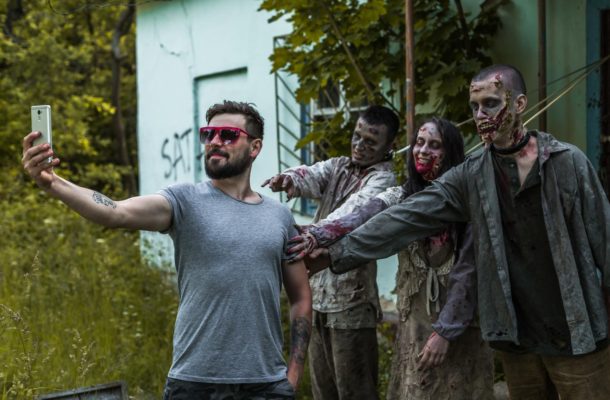The hard science behind surviving a zombie attack

When it comes to surviving a plague of infectious zombies, there is safety in numbers. And failing that…run like a bat out of hell.
“You need to build a defensive ring around the source of any attack to overpower the zombies with numbers, because if you miss that chance they will just overpower everyone as long as they have contact with a population,” warns Professor Greg Foliente, Deputy Director of the University of Melbourne’s Centre for Disaster Management and Public Safety (CDMPS).
“Alternatively, if you have enough warning, disperse as fast as you can.”
Professor Foliente and his CDMPS colleagues are usually spatial modelling to forecast the impact of disasters like floods and bushfires – these models break down populations and areas into smaller zones to map what might happen on the ground during a disaster.
So, when Xbox wanted to promote its new zombie game State of Decay 2 by simulating zombie outbreaks in Australian and New Zealand cities, they naturally called up Professor Foliente.
“At first, I thought it was a crazy idea, but I’ve always been interested in epidemiology and applying our spatial modelling if there is an infectious disease outbreak, so I thought about it and we gave it a go.”
They found that zombie outbreaks in larger cities have a greater chance of being contained so long as the citizens band together to fight it out. But in lower density areas, there just aren’t enough people to fight back effectively; there are, however, enough of us for the zombies to feed on and continue to spread.
While big cities like Sydney and Melbourne suffered a large number of infections – more than 200,000 within six days – the rates of infection were highest in smaller cities like Perth and Auckland, flattening out at 6 per cent within the first 360 hours.
That compares with an infection rate in Sydney stabilising at just over 3 per cent. In a small city like Queenstown in New Zealand, the infection rate just keeps rising until the population is completely overpowered.
“It shows what spatial simulation modelling can do,” says Professor Foliente. “With this exercise we can learn the nature of propagation of an outbreak based on current knowledge and assumptions, and by doing that we can learn the best defence by simulating different scenarios.”
Professor Foliente and his colleague Dr Yiquen Chen, used a model developed by Cornell University researchers in 2015 called the SZR (Susceptible-Zombie-Removed) that was developed to test out modelling techniques for zombie attacks and compare them with traditional models for the spread of diseases.
The SZR model assumes that one zombie bite is enough to infect a human and in a one-on-one encounter a zombie is more likely to bite a human than be killed. It also assumes that zombies can only walk or run – they can’t drive cars, ride a bike or catch a train – and that humans stay in their locale rather than flee.
Zombie scenarios inform real life disaster planning
We are weirdly fascinated by zombies – reanimated dead people who are very far from being pleasant, or even that animated. Through movies and TV shows like World War Z or The Walking Dead they have become a cult phenomenon, spawning festivals and even running apps where joggers are goaded to go faster by the threat of walking corpses.
But epidemiologists love them too as an engagement tool for modelling outbreaks.
The US Centres for Disease Control and Prevention has enthusiastically embraced zombies as a tool to get people thinking about how to prepare for a major emergency. That is despite having its building blown up in an episode of The Walking Dead.
One of the CDC’s helpful recommendations includes “plan your evacuation route. When zombies are hungry they won’t stop until they get food (i.e. brains), which means you need to get out of town fast!”
In their modelling, the CDMPS researchers used different scenarios based on where a zombie outbreak might start.
They assumed that in Australia, being an island, zombies are more likely to enter through airports or sea ports.
They found that when it comes to zombies with air tickets, you are better off being in Sydney rather than Melbourne because the airport there is in a dense population area which will have a better chance of fighting back and containing the outbreak.
Zombies arriving at Melbourne’s Tullamarine airport are more likely to overwhelm the sparser surrounding population and successfully spread into the city.
However, zombie stowaways landing at the port of Geelong will run out of people to eat before they can spread the 65 kilometres to Melbourne.
Wherever a zombie outbreak starts, Professor Foliente says that just like any infectious disease outbreak, the sooner we discover it and react, the better.
Regardless of the population density or geography, how humans react in the first 12 hours is very important.
“Early detection is important, and if contained immediately by people overpowering and killing zombies when they are few in numbers, then the urban population will be saved. Otherwise it is just a matter of time before they completely takeover.”
Maybe we need to start work on a vaccine.
This article was published by Pursuit.
Andrew Trounson is a senior journalist for the University of Melbourne’s Pursuit magazine. He was previously an education correspondent for The Australian.











